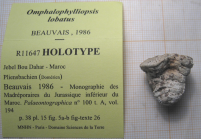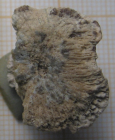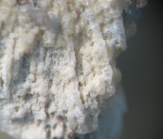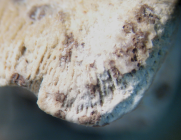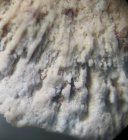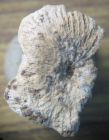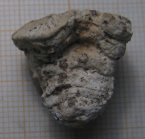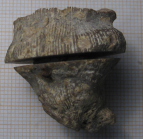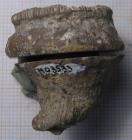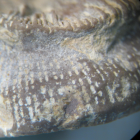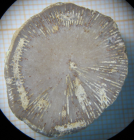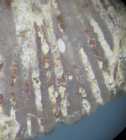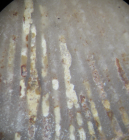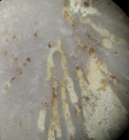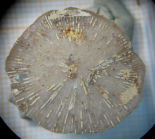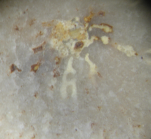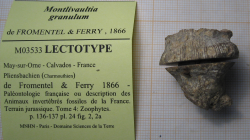
| Intro | | About | | Wiki | | Search traits | | Data explorer | | Literature | | Definitions | | Sources | | Webservices | | Statistics | | Feedback | | Editors | | Log in |
WoRMS taxon detailsProleptophyllia Alloiteau, 1952 †
1581241 (urn:lsid:marinespecies.org:taxname:1581241)
accepted
Genus
Montlivaultia granulum de Fromentel & de Ferry, 1866 † accepted as Proleptophyllia granulum (de Fromentel & de Ferry, 1866) † (type by monotypy)
Omphalophylliopsis L. Beauvais, 1986 † · unaccepted > junior subjective synonym
marine,
fossil only
Alloiteau J. (1952). Embranchement des Coelentérés. Madreporaires Post-Paleozoiques. <em>In: Piveteau J, ed. Traité de Paléontologie, Paris: Masson.</em> 539–684, pls. 1-10. [details]
Description Solitary trochoid corallum cemented on an attachment area. Elliptical calice. Superficial calicular platform . Radial...
Description Solitary trochoid corallum cemented on an attachment area. Elliptical calice. Superficial calicular platform . Radial elements are subcompact , straight, anastomosing or free septa or costosepta. with parallel faces. Septa globally attenuated but strongly ornamented, moderately exsert. Lateral faces show pennule like flat granules that do not alternate between neighbouring septa and are not arranged in continuous menianae. The distal edge is ornamented of strong teeth. More the teeth are in the axial region bigger and more detached they are. They produce in the center the appearance of a papillose columella but without relief.. Probable hexameral arrangement. Abundant endotheca. The transverse section of the lectotype does not allow to differentiate synapticules of thick dissepiments. Wall externally smooth, of unknown nature, covering the external part of radial elements. [details]
Hoeksema, B. W.; Cairns, S. (2024). World List of Scleractinia. Proleptophyllia Alloiteau, 1952 †. Accessed through: World Register of Marine Species at: https://www.marinespecies.org/aphia.php?p=taxdetails&id=1581241 on 2024-09-06
Date action by
original description
Alloiteau J. (1952). Embranchement des Coelentérés. Madreporaires Post-Paleozoiques. <em>In: Piveteau J, ed. Traité de Paléontologie, Paris: Masson.</em> 539–684, pls. 1-10. [details]
original description (of Omphalophylliopsis L. Beauvais, 1986 †) Beauvais L. (1986). Monographie des madréporaires du Jurassique inférieur du Maroc. <em>Palaeontographica (A).</em> 194 (1/3): 1–68. [details] basis of record Cairns, S.D., R. Baron-Szabo, A.F. Budd, B. Lathuilière, E. Roniewicz, J. Stolarski & K.G. Johnson. (2010). Corallosphere. , available online at http://www.corallosphere.org [details] additional source Vasseur, R., Lathuilière, B. (2021). Pliensbachian corals from the Western Tethys. <em>Geodiversitas.</em> 43(22): 1187-1291., available online at https://doi.org/10.5252/geodiversitas2021v43a22 [details]  Present Present  Inaccurate Inaccurate  Introduced: alien Introduced: alien  Containing type locality Containing type locality
From editor or global species database
Description Solitary trochoid corallum cemented on an attachment area. Elliptical calice. Superficial calicular platform . Radial elements are subcompact , straight, anastomosing or free septa or costosepta. with parallel faces. Septa globally attenuated but strongly ornamented, moderately exsert. Lateral faces show pennule like flat granules that do not alternate between neighbouring septa and are not arranged in continuous menianae. The distal edge is ornamented of strong teeth. More the teeth are in the axial region bigger and more detached they are. They produce in the center the appearance of a papillose columella but without relief.. Probable hexameral arrangement. Abundant endotheca. The transverse section of the lectotype does not allow to differentiate synapticules of thick dissepiments. Wall externally smooth, of unknown nature, covering the external part of radial elements. [details]Remark Alloiteau 1957 considered that there is no wall but an epitheca "of endothecal origin" covering the costal part of costosepta. It is possibly true but we can also equally consider that true septa s.s. are exsert in the outer margin and then, the peripheric tissue would be a wall. [details] |
